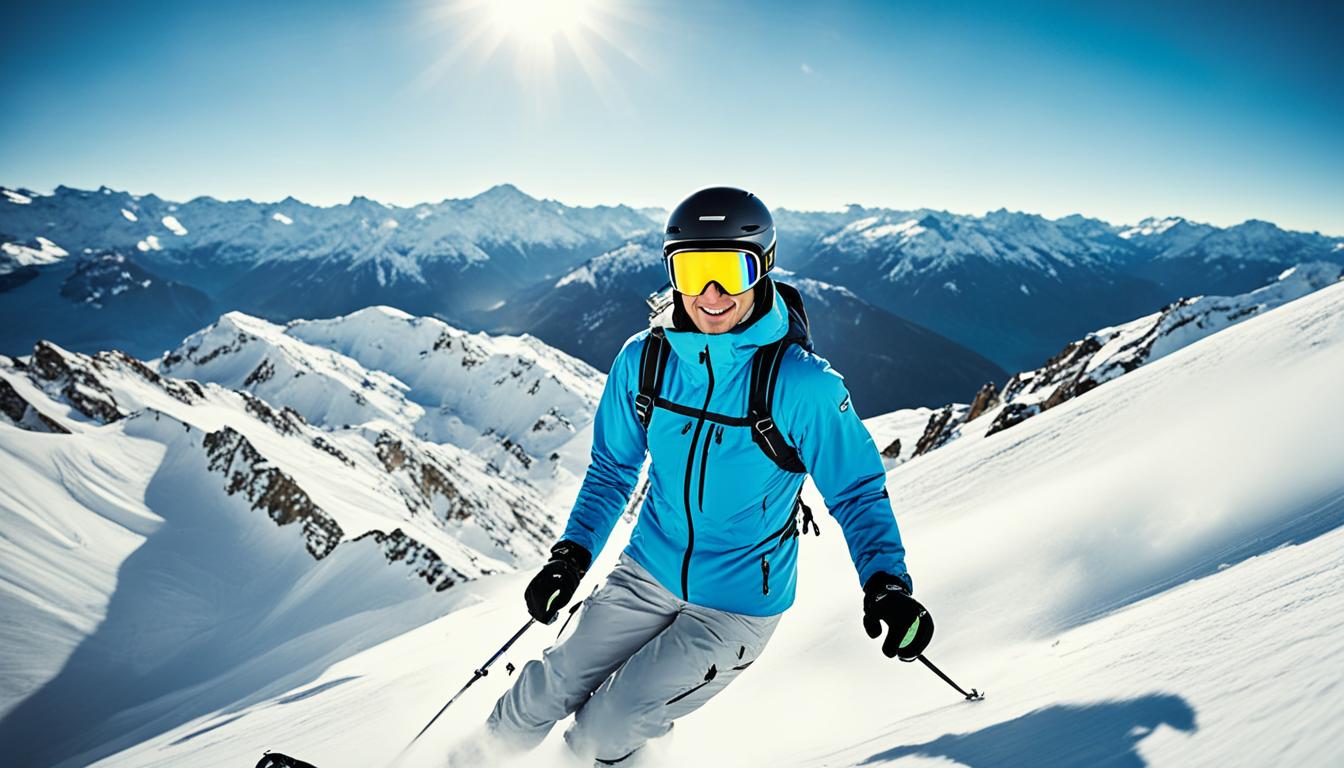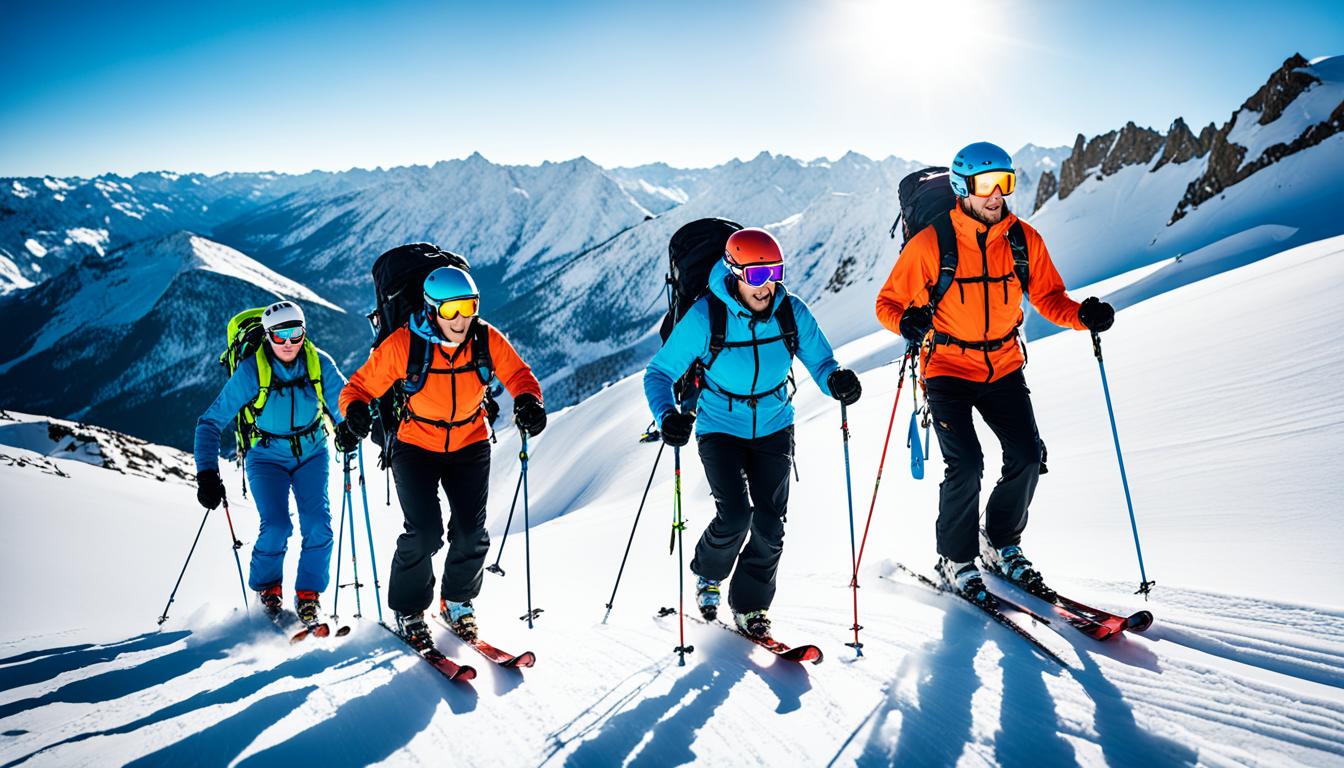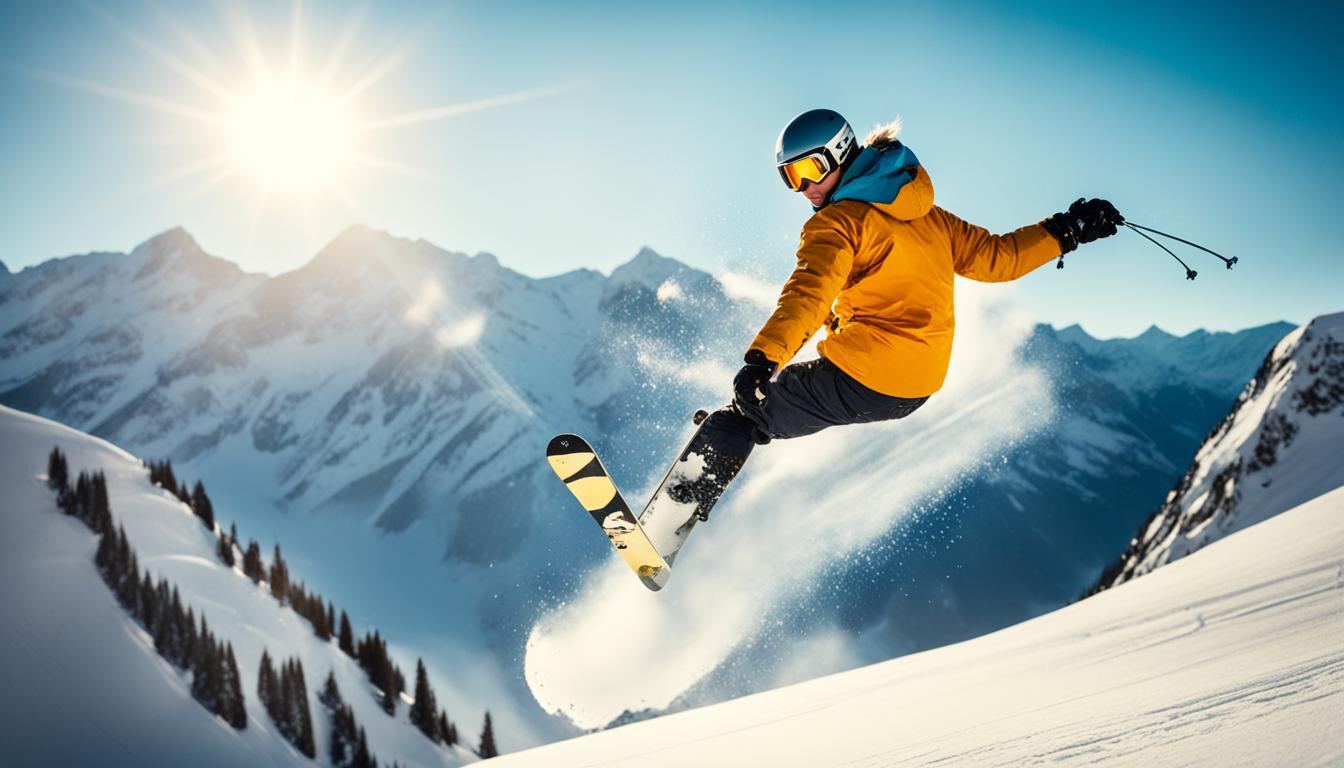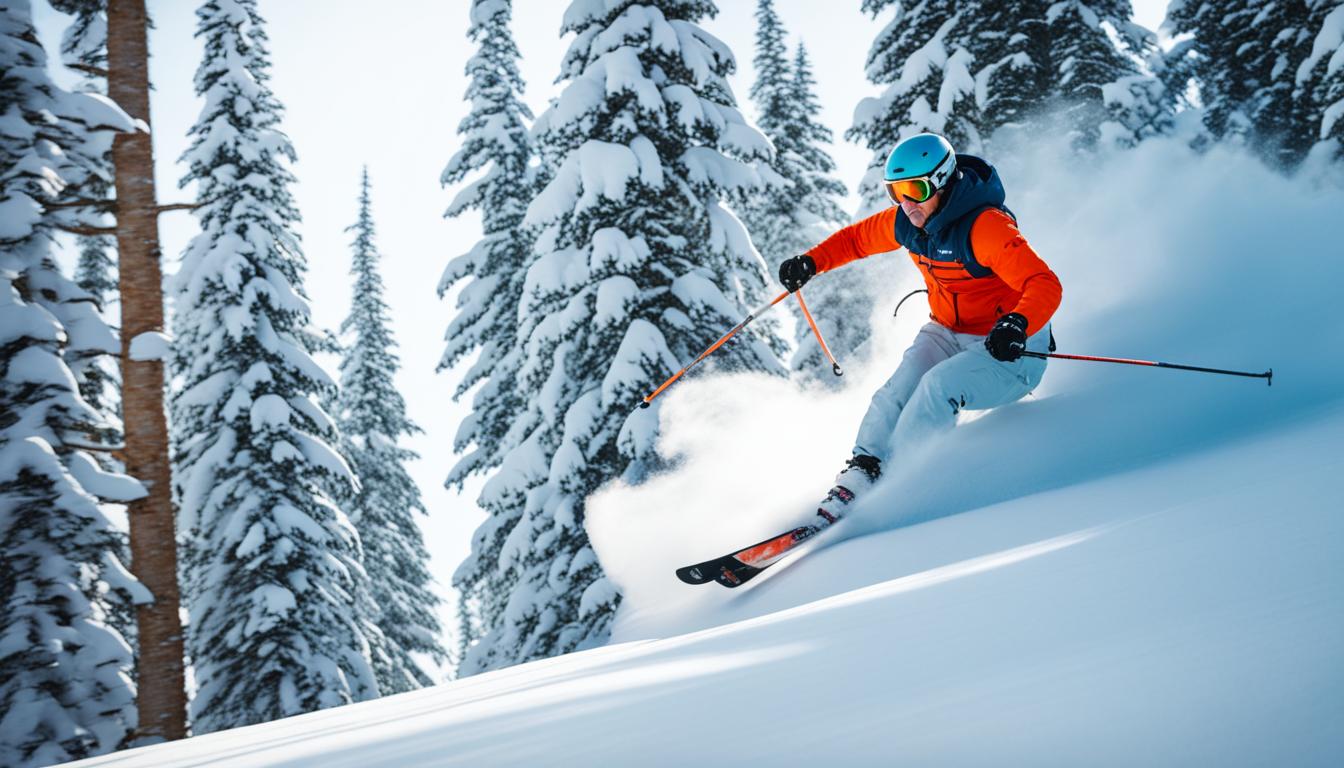Welcome to our guide to high-altitude skiing and acclimatization. If you’re planning a ski trip in the mountains and want to make the most of your experience while staying safe, this is the resource for you. Skiing at high altitudes can be a thrilling adventure, but it’s essential to take precautions and acclimatize properly to prevent altitude sickness and ensure a memorable time on the slopes.
In this article, we’ll provide you with valuable tips, techniques, and gear recommendations for high-altitude skiing. From acclimatization strategies to recognize symptoms of altitude sickness, we’ve got you covered. So, let’s dive in and get ready for an amazing skiing adventure!
Key Takeaways:
- Acclimatize gradually to high altitudes to prevent altitude sickness.
- Stay hydrated and maintain an electrolyte balance throughout your ski trip.
- Choose the right gear and equipment, including a comfortable ski tour backpack.
- Research and select ski resorts with lower base altitudes to minimize the risk of altitude sickness.
- Recognize the symptoms of altitude sickness and take appropriate action if they occur.
Symptoms of Altitude Sickness
Altitude sickness is a common concern when embarking on a high-altitude ski tour. It’s essential to be aware of the symptoms to ensure your safety and prevent any complications. Some of the most common altitude sickness symptoms include:
- Headaches
- Nausea
- Dizziness
- Tiredness
- Loss of appetite
- Shortness of breath
Recognizing these symptoms is crucial in addressing any potential issues. To prevent altitude sickness during your ski touring adventure, it’s important to plan your route and itinerary carefully. Consider the altitude and take into account your body’s ability to adjust to higher altitudes. Additionally, factors such as avalanche risk, health and safety measures, and equipment checking should be prioritized.
“Altitude sickness can be unpredictable, and it’s important to prioritize your health and well-being. By recognizing the symptoms and taking appropriate measures, we can ensure a safe and enjoyable ski touring experience.”
Ensuring your safety while ski touring at high altitudes involves being prepared and proactive. Here are a few measures to consider:
- Plan your ski touring route, taking into account the altitude and potential risks, such as avalanche-prone areas.
- Check the weather forecast and avalanche conditions before setting out on your ski touring adventure.
- Follow health and safety protocols, including proper equipment checking, such as avalanche safety gear and ski bindings.
- Stay hydrated throughout your ski tour, as dehydration can exacerbate altitude sickness symptoms.
- Take breaks and allow your body to acclimate gradually to higher altitudes.
| Symptom | Prevention/Treatment |
|---|---|
| Headaches | Stay hydrated, rest, and consider over-the-counter pain relievers if necessary. |
| Nausea | Drink plenty of fluids, eat small and frequent meals, and avoid heavy or greasy foods. |
| Dizziness | Take frequent breaks, sit or lie down if needed, and ensure proper hydration. |
| Tiredness | Get enough rest and sleep, pace yourself during skiing, and prioritize hydration. |
| Loss of appetite | Opt for small and frequent meals, focus on easily digestible foods, and prioritize hydration. |
| Shortness of breath | Rest and allow your body to acclimate, avoid exertion, and ensure proper hydration. |
Acclimatization Techniques for High-Altitude Skiing
When embarking on a high-altitude ski tour, acclimatization becomes paramount. The thin air and challenging conditions at higher altitudes require careful preparation and adaptation of the body. By following key acclimatization techniques, you can maximize your performance and minimize the risk of altitude sickness.
- Climb Steep, Sleep Low: One of the most effective acclimatization methods is the “climb steep, sleep low” strategy. This involves climbing to higher altitudes during the day to expose your body to challenging conditions and then descending to lower altitudes for restful sleep. This technique helps your body adjust to the thin air and reduces the chances of altitude sickness.
- Hydration and Electrolyte Balance: Staying hydrated is crucial in high-altitude environments. The dry air and increased exertion can lead to dehydration, which can exacerbate altitude sickness. Ensure you drink plenty of water throughout the day to maintain optimal hydration levels. Additionally, pay attention to your electrolyte balance by consuming sports drinks or electrolyte-rich foods.
- Calorie Intake: High-altitude skiing requires increased energy expenditure due to the demanding conditions. It’s important to fuel your body with a light but high-calorie diet to sustain energy levels. Opt for nutrient-dense foods that provide the necessary fuel for your muscles to perform optimally.
- Slow Pace: Skiing at a slow pace is crucial for proper acclimatization. Rushing into intense physical activity at high altitudes can strain the body and increase the risk of altitude sickness. Take your time to adapt to the challenges of the environment and listen to your body’s cues.
By implementing these acclimatization techniques, you give your body the best opportunity to adjust and thrive in high-altitude skiing conditions. Remember to take it slow, stay hydrated, maintain electrolyte balance, and nourish your body with adequate calories. Safe and enjoyable high-altitude skiing starts with proper acclimatization.
Gear and Equipment for High-Altitude Skiing
When it comes to high-altitude skiing, having the right gear and equipment is crucial to ensure your safety and enhance your overall experience. Here are some essential items that should be on your checklist:
Ski Tour Backpack
A ski tour backpack is an essential piece of equipment for high-altitude skiing. Look for a backpack that offers a comfortable fit and is compatible with a hydration system. The hydration system will keep you hydrated throughout your ski tour, ensuring optimal performance on the slopes.
Ski Tour Volume
The recommended volume for a ski tour backpack is around 30-40 liters. This size is ideal for carrying all your necessary gear and essentials without being too bulky or restrictive during your ski tour. Consider the specific requirements of your trip and the gear you plan to bring when selecting the volume of your backpack.
Comfortable Skiing Gear
Investing in comfortable skiing gear is essential for a pleasant and enjoyable high-altitude skiing experience. Make sure your ski boots fit properly and provide the necessary support. Wear layers of moisture-wicking and insulating clothing to stay warm and dry in varying weather conditions. Don’t forget to wear a helmet to prioritize your safety on the slopes.
Ski Tour Essentials
It’s important to pack essential items that will contribute to your comfort and safety during your ski tour. Some of these essentials include:
- Extra Layers: Pack additional clothing layers, such as thermal base layers, fleece jackets, and waterproof outer shells, to adjust to changing weather conditions.
- Sunscreen: Protect your skin from the harsh rays of the sun at high altitudes by applying sunscreen with a high SPF.
- First Aid Kit: Carry a compact first aid kit containing supplies for minor injuries or emergencies.
- Navigation Tools: Bring a map, compass, GPS device, or smartphone app to help you navigate the ski tour route and stay on track.
By ensuring you have the right gear and equipment, you’ll be well-prepared to tackle the challenges of high-altitude skiing and make the most out of your adventure on the mountain.
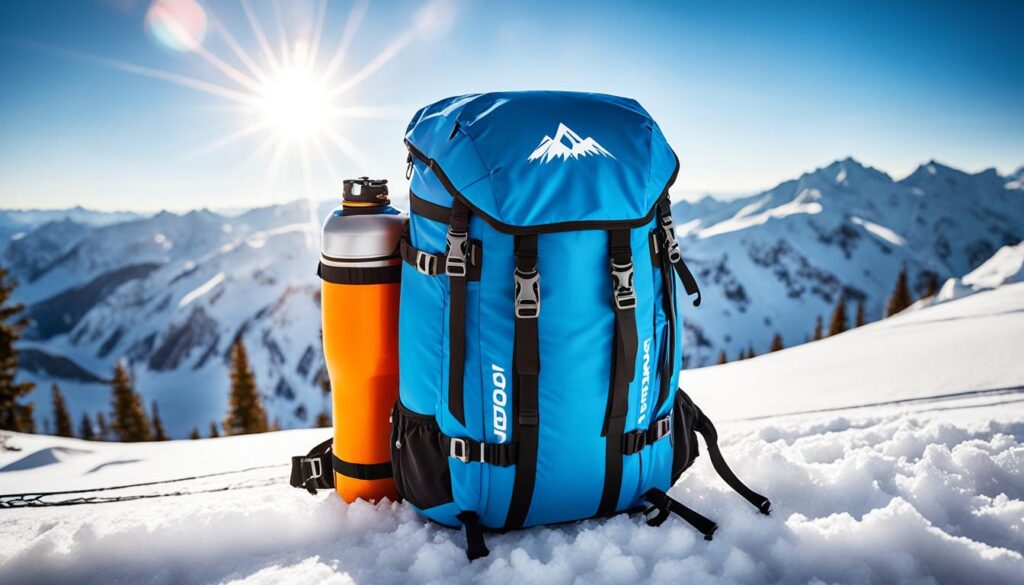
| Item | Description |
|---|---|
| Ski Tour Backpack | Comfortable fit, hydration system compatibility |
| Ski Tour Volume | Recommended: 30-40 liters |
| Comfortable Skiing Gear | Properly fitted ski boots, moisture-wicking and insulating clothing, helmet |
| Ski Tour Essentials | Extra layers, sunscreen, first aid kit, navigation tools |
Best Ski Resorts for Altitude Sickness Prevention
When planning a high-altitude skiing trip, choosing the right ski resort can greatly reduce the risk of altitude sickness. Ski resorts with base altitudes below 5,000 feet are generally recommended for individuals who are prone to altitude sickness. Let’s take a look at a few ski resorts that fit this criteria:
- Bretton Woods Mountain Resort, New Hampshire
- Killington Ski Resort, Vermont
- Mount Snow, Vermont
Located in the White Mountains of New Hampshire, Bretton Woods Mountain Resort offers a base altitude of approximately 1,600 feet. This lower altitude can help skiers acclimate gradually and reduce the chances of experiencing altitude-related symptoms.
As the largest ski area in the eastern United States, Killington Ski Resort boasts a base altitude of around 1,165 feet. This resort offers a wide range of slopes and terrain, making it a popular choice among skiers of all levels. The lower base altitude makes it a suitable option for those concerned about altitude sickness.
With a base altitude of approximately 1,900 feet, Mount Snow in southern Vermont is another ski resort that can help mitigate altitude sickness. Its diverse trail options and family-friendly atmosphere make it a great destination for skiers of all ages and abilities.
When selecting a ski resort, it’s important to consider not only the base altitude but also the summit altitude and overall altitude threshold. Altitude sickness becomes more prevalent as you ascend to higher elevations, so choosing a resort with a moderate summit altitude is another key factor to consider.
Remember, everyone’s body reacts differently to high altitudes, and altitude sickness can affect even the most experienced skiers. It’s essential to consult with a healthcare professional and take the necessary precautions to ensure a safe and enjoyable skiing experience.
Tips to Avoid Altitude Sickness While Skiing
When embarking on a high-altitude skiing adventure, it’s important to take measures to prevent altitude sickness and ensure a safe and enjoyable experience. Here are some tips and strategies to help you avoid altitude sickness:
- Stay Hydrated: Drinking plenty of water is crucial for preventing altitude sickness. Dehydration can worsen symptoms, so make sure to stay hydrated throughout your skiing trip.
- Acclimate Gradually: Gradually acclimating your body to higher altitudes can greatly reduce the risk of altitude sickness. Spend a night or two at intermediate altitudes before reaching your final skiing destination.
- Get Enough Sleep: Adequate rest is essential for acclimatization. Make sure to get enough sleep before and during your skiing trip to allow your body to adjust to the high altitude.
- Take it Easy Skiing: Skiing at a slow and relaxed pace allows your body to adapt to the thin air and reduce the risk of altitude sickness. Avoid pushing yourself too hard and take breaks when needed.
- Limit Alcohol and Caffeine: Alcohol and caffeine can dehydrate your body, making you more susceptible to altitude sickness. Limit your consumption of these substances while skiing at high altitudes.
- Ski High and Sleep Low: Following the “ski high and sleep low” method can improve acclimatization. Spend your days skiing at higher altitudes and then descend to lower altitudes for rest and sleep.
- Take Antioxidants: Antioxidants can help protect your body against the effects of high altitude. Consider taking supplements or consuming foods rich in antioxidants, such as berries, dark chocolate, and green tea.
By following these tips, you can reduce the risk of altitude sickness and fully enjoy the breathtaking slopes of your high-altitude skiing adventure.
Altitude Sickness Prevention Tips
| Tip | Description |
|---|---|
| Stay Hydrated | Drinking plenty of water helps prevent dehydration and alleviate altitude sickness symptoms. |
| Acclimate Gradually | Gradually ascending to higher altitudes allows your body to adjust and reduce the risk of altitude sickness. |
| Get Enough Sleep | Adequate rest promotes proper acclimatization and helps prevent altitude sickness. |
| Take it Easy Skiing | Ski at a slow pace to give your body time to adapt to the thin air and minimize altitude sickness. |
| Limit Alcohol and Caffeine | Reducing alcohol and caffeine intake can prevent dehydration and enhance acclimatization. |
| Ski High and Sleep Low | Follow the “ski high and sleep low” method to improve acclimatization by spending days at higher altitudes and nights at lower altitudes. |
| Take Antioxidants | Antioxidants protect your body from the effects of high altitude. Consider taking supplements or consuming antioxidant-rich foods. |
Recognizing and Responding to Altitude Sickness Symptoms
When engaging in high-altitude skiing, it is crucial to be able to recognize and respond promptly to altitude sickness symptoms. By being aware and taking appropriate action, you can protect your health and safely enjoy your skiing adventure. Here are the key steps to follow:
1. Stop Ascending Immediately
If you start experiencing symptoms such as headaches, nausea, difficulty sleeping, or a rapid heartbeat, it is essential to halt your ascent to higher altitudes. Continuing to ski or climb at high altitudes can exacerbate the symptoms and put your well-being at further risk.
2. Rest and Hydrate
Find a comfortable place to rest and hydrate your body. Sit down, take deep breaths, and give yourself time to acclimate. Replenish lost fluids by drinking plenty of water to stay hydrated. Remember that dehydration can worsen altitude sickness symptoms.
3. Descend if Symptoms Worsen
If your symptoms persist or worsen even after resting and hydrating, it is crucial to descend to a lower altitude. This allows your body to adjust and recover from the effects of high altitude. Descending to a lower elevation can provide relief and prevent further complications.
4. Seek Medical Help
If you are experiencing severe symptoms or you are concerned about your condition, do not hesitate to seek medical assistance. Medical professionals have the expertise to evaluate your situation and provide appropriate guidance and treatment. Altitude sickness should always be taken seriously to ensure your well-being and prevent any potential complications.
“Recognizing and responding promptly to altitude sickness symptoms can make a significant difference in your safety and enjoyment while skiing at high altitudes. Take immediate action if you experience any symptoms, prioritize rest and hydration, and seek medical help when needed. Your health and well-being are our top priorities.”
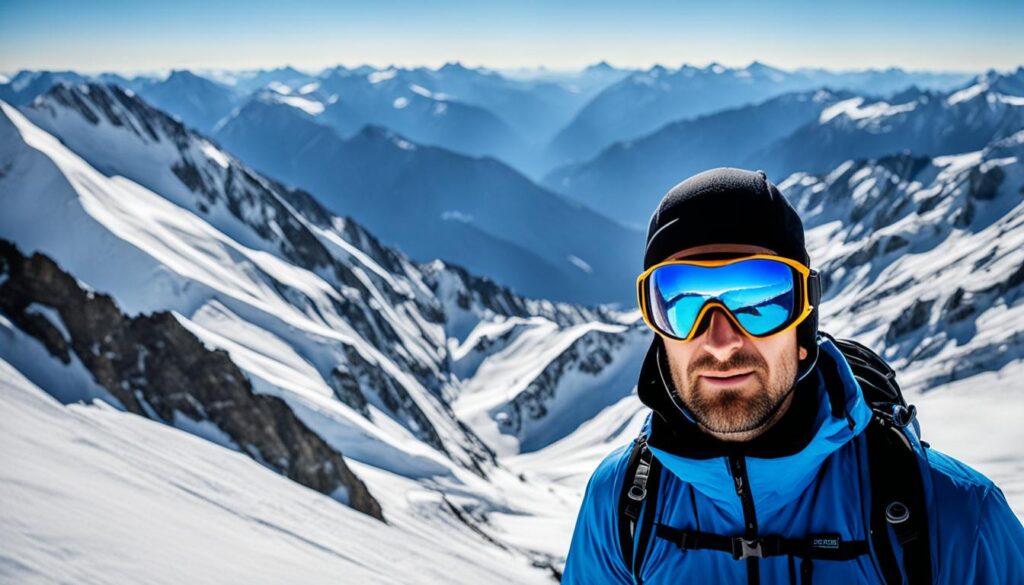
By following these steps and taking the necessary precautions, you can minimize the impact of altitude sickness and ensure a safe and enjoyable high-altitude skiing experience. Remember that your body needs time to acclimate to higher altitudes, so listen to your body, be aware of any symptoms, and take action accordingly.
| Altitude Sickness Symptoms | Actions to Take |
|---|---|
| Headaches, nausea, dizziness | Stop ascending, rest and hydrate |
| Tiredness, loss of appetite | Descend if symptoms worsen |
| Shortness of breath, rapid heartbeat | Seek medical help |
Conclusion
High-altitude skiing can be an exhilarating and unforgettable experience, and with the right precautions, you can enjoy it safely. Throughout this guide, we have provided you with essential high-altitude skiing tips and acclimatization techniques to ensure your well-being on the slopes.
By planning your ski tour carefully, allowing yourself to acclimate gradually to higher altitudes, and staying hydrated, you can minimize the risk of altitude sickness and fully enjoy the thrill of high-altitude skiing. It’s also crucial to eat a balanced diet, ski at a slow pace, and be aware of any symptoms of altitude sickness that may arise.
With proper preparation, including selecting the right ski gear and choosing a ski resort that aligns with your acclimatization needs, you can embark on your high-altitude skiing adventure with confidence. Remember, your safety and enjoyment are our utmost priority, so don’t hesitate to seek medical help if needed.
So get ready to hit the slopes, take in the breathtaking mountain views, and create lasting memories while high-altitude skiing. Follow these tips, acclimatize effectively, and enjoy the beauty of skiing in the high altitudes, knowing that you’ve taken the necessary steps to ensure your safety and well-being. Happy skiing!
FAQ
What are the symptoms of altitude sickness?
The symptoms of altitude sickness can include headaches, nausea, dizziness, tiredness, loss of appetite, and shortness of breath.
How can I prevent altitude sickness while ski touring?
To prevent altitude sickness while ski touring, it’s important to plan your route and itinerary, check for avalanche risk, ensure health and safety measures are in place, and check your equipment.
What are some acclimatization techniques for high-altitude skiing?
One acclimatization technique is the “climb steep, sleep low” method, which involves ascending to higher altitudes during the day and descending to lower altitudes for sleep. Staying hydrated and maintaining an electrolyte balance, eating a high-calorie diet, and skiing at a slow pace can also aid acclimatization.
What gear and equipment do I need for high-altitude skiing?
Essential gear for high-altitude skiing includes a ski tour backpack with a comfortable fit and hydration system compatibility. It’s important to pack extra layers, sunscreen, a first aid kit, and navigation tools.
Which ski resorts are best for preventing altitude sickness?
Ski resorts with base altitudes below 5,000 feet generally have a lower risk of altitude sickness. Some examples include Bretton Woods Mountain Resort in New Hampshire, Killington Ski Resort in Vermont, and Mount Snow in Vermont.
What are some tips to avoid altitude sickness while skiing?
Staying hydrated, acclimating gradually by spending a night or two at intermediate altitudes, getting enough sleep, skiing at a slow pace, limiting alcohol and caffeine intake, and following the “ski high and sleep low” method or taking antioxidants can all help prevent altitude sickness.
How can I recognize and respond to altitude sickness symptoms while skiing?
If you experience symptoms such as headaches, nausea, difficulty sleeping, or a rapid heartbeat, it’s important to stop ascending immediately and find a comfortable place to rest and hydrate. If symptoms worsen or persist, descending to a lower altitude is advised. In severe cases or if you’re concerned about your condition, seeking medical help is essential.
How can I enjoy high-altitude skiing safely?
By following the tips and techniques outlined in this guide, such as planning your ski tour, acclimating gradually, staying hydrated, eating a balanced diet, skiing at a slow pace, and being aware of altitude sickness symptoms, you can enjoy high-altitude skiing safely.

